In this part 4 of the Yoga on the Trail study we will take a look at balance poses and inversions.
I have already talked about the importance of asanas in general. Without a regular practice of asanas I begin to feel very muscle-bound in the arms, shoulders and legs. My muscles tighten from the repetitive action of walking, lifting the pack, and lowering the pack. Additionally, asanas allow flexibility for all the awkward movements that come with backpacking, such as climbing over trees that have fallen across the trail, or slipping on snow.
To counterbalance the efforts required, I follow the classical teachings of a balanced asana practice. I do at least one of each of the six types of postures: forward bend, backward bend, side bend, twist, inverted and balance.
Speaking of balance, there can be many stream crossings during a hike and having good balance is important. All balance poses are an asset; not just for creek fords, but also for ridge-walking, rock climbing, and scree slopes. Plus (extra bonus!) having good balance can help to prevent twisting an ankle while carrying all that weight on your back!
Our sense of balance can change daily. In part, balance can depend on our state of mind. It can also depend on our state of health. For example, if our inner ear is blocked, or we are dehydrated, or a muscle is injured, or we are at a higher altitude than our body is used to, these can all impact our sense of balance. Let’s take a look at some balance poses that can help us out on the trail.
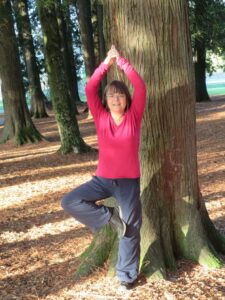
Dorothy Fizzell, in Vrksasana, on the trail in Ajijic, Mexico
A Variety of Yoga Poses for on the Trail
Vrksasana (tree pose), is excellent for stretching the quadriceps in the bent leg and strengthening them in the standing leg. It also strengthens the ankle and foot in the standing leg. If your balance is off a bit, the tree pose is easily modified by either keeping the raised leg closer to the ground, either below the knee or even the toe resting on the ground. You can also place one of the arms against a tree or other natural object for support. To help succeed in the pose, focus the eyes nice and steady on an object in front of you. This “Drishti” or place where you hold your gaze can help to keep your balance. A focused mind can become a calm mind, and this too can be helpful in reducing any mental stress.
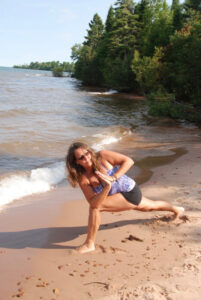
Terri McDermott, in Parvritta Anjaneyasana, on the beach in Vieques Island, Puerto Rico
Parvritta Anjaneyasana (revolved lunge pose) stretches the hip flexors, quadriceps, calf muscles, and achilles tendon in the back leg. The front leg strengthens and stabilizes while the glutes stretch. This pose adds a twist to the body that nicely stretches across the back and shoulders. Again, the focused mind takes you to a place of inner calm which will assist in successful balancing.
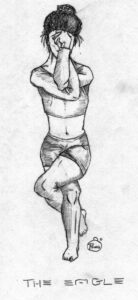
image: Thor Polukoshko
Garudasana (eagle pose) is another option for balancing. The intertwining of the “eagle arms” will stretch the muscles across the back, while the intertwined legs will stretch across the hips. If balance is a challenge, this pose can be modified by keeping the toes of the upper leg resting on a rock or on the ground.
In part 2 we discussed Bakasana (crow pose) for strengthening the arms and core while focusing on balance.
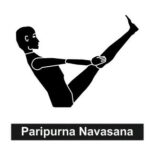 Navasana (boat pose) is a seated balance pose that will strengthen the abdominal muscles. You can bend the knees to a 90 degree angle, or only raise one leg at a time if it is too challenging to have both legs straight.
Navasana (boat pose) is a seated balance pose that will strengthen the abdominal muscles. You can bend the knees to a 90 degree angle, or only raise one leg at a time if it is too challenging to have both legs straight.
And of course, add your own favourite balance poses to your trail yoga practice. I love some of the stronger balance asanas which are also inverted asanas.
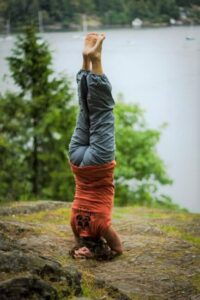
Mugs in the headstand Shirshasana.
Shirshasana (headstand), is a favourite of mine. While focusing on balance, the inversion can give a fresh perspective for seeing things differently. Getting upside down shifts our vision, allowing us to have a changed point of view. This can be extremely helpful while facing challenges while living in the wild.

Mugs in the variation of headstand Padma Shirshasana.
Padma-Shirshasana is where you go into headstand and then fold the legs into lotus pose.
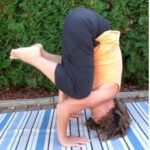
Kapalasana is a very stable variation of headstand.
A simpler, modified version of the headstand is Kapalasana (teddy bear pose). In this pose you can work more easily with balance by creating a tripod with the hands and head. Then balance the knees onto the upper arms. You benefit from the changed view and balancing without as much effort being required.
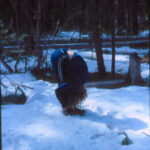
Mugs doing yoga on the trail with the forward fold, Uttanasana.
There are numerous other variations for these asanas which can add variety to your practice. This will benefit different muscles by stretching in different ways and giving the mind some food for thought.
Padahastasana (aka hands-to-feet pose, aka Uttanasana) is a standing forward bend and a gentle inversion pose. It classifies as an inversion because the head is lower than the heart. This standing pose is easily adaptable to almost all conditions on the trail. You’ll get a great low back stretch along with the hamstrings too. Depending on how level the ground is, it can take a little balance to do it.
Surya Namaskar (sun salutation) and Chandra Namaskar (moon salutation). These are sequences of asanas intended for warming up, opening and closing the body in numerous directions. When the conditions are suitable these can be great options for asana practice.
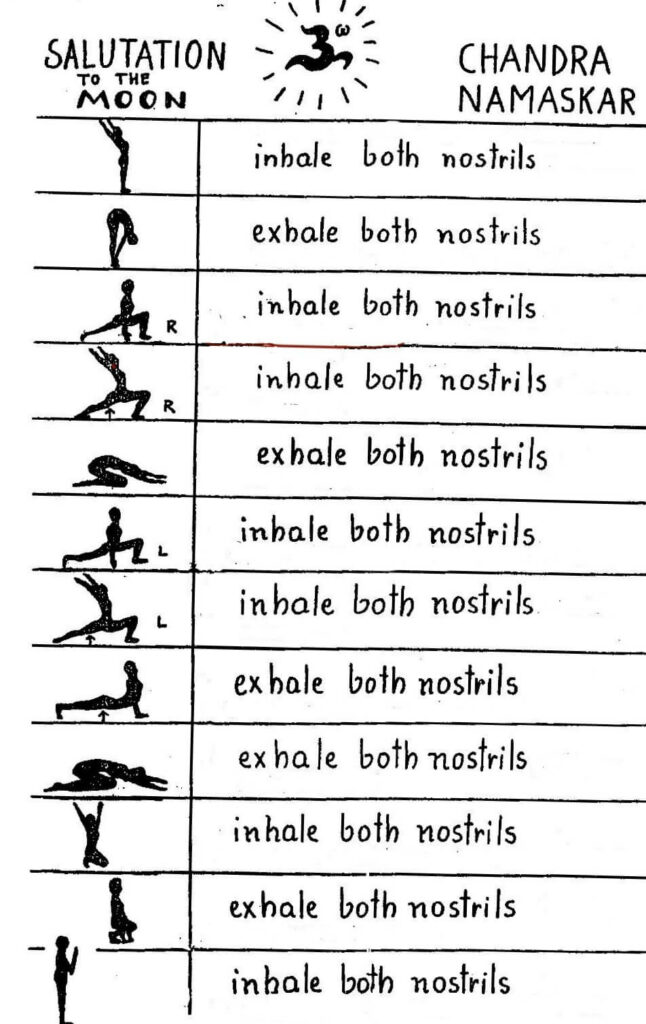
There are many different sun and moon salutation sequences today that can be adapted and modified to suit your needs on the trail. This is one sequence on page 52 in my book Letters from the Yoga Masters. My teacher Hari taught me. It is a little awkward at first with hiking boots on, but if conditions allow for it, do it bare foot. With every stretch and bow, give reverence to the earth and sky. Choose the right sequence for the trail conditions you are in at the time.
Considering “balance”, there is more to consider than just physical balance. These sequences are excellent for balancing and stimulating the bodily systems: the muscular system, nervous system, endocrine system, respiratory system, cardiovascular system, lymphatic system, and digestive system. The weight-bearing postures assist with bone density. How perfect is that?
Yoga Asanas in the Tent
So, what about inclement weather conditions? These are inevitable when one goes on an extended hiking trip. The desert can offer some restrictions to your practice of asanas when the temperatures are high, such as 32°C to 38°C (90°F to 100°F). Only mild stretches should be done so as not to cause overheating of the body. Remember to watch for thistles, cactus, rocks and poisonous critters when you are doing your postures. Do your practice on your sleeping pad or yoga mat to avoid some of the prickles or hot sand.
How do we do our practice when it is muddy or snowy? Many variations are adaptable by using your environment as props. We have touched on some variations in Part 3 that can prevent needing to sit on the ground.
Adapt the time of day you do your practice to the conditions you are in. The best times for me in the desert were early morning or late afternoon when the temperatures are the coolest. In the mountains I chose mid-day or just before supper and sunset, when it was still warm out.
But what if the weather conditions are so poor? It is blizzarding, or a thunder storm, or with an abundance of mosquitoes? Then do your yoga in the tent! Of course, you will need a willing partner who will curl into the corner while you do your asanas, and hopefully you have a tent large enough to accommodate your length and height when sitting and kneeling. I did my asanas in the tent while supper was being prepared by my sister.
In Parts 1, 2 and 3 we have covered a variety of poses that are done seated, kneeling, prone or supine, and they include the 6 kinds of poses for balancing the body: forward bend, back bend, side bend, twist, balance and inversions. Many of these are adaptable to be done inside the tent.
Let’s talk a little more about twisting poses. In the twist, either the hips remain stable while the shoulders rotate, or the shoulders remain stable while the hips rotate. Twists nourish the nerves along the spine while engaging and stretching small back muscles. The spine realigns. Digestion is stimulated. A few twisting poses suited for the tent are added here.
Jathara Parivartanasana is a supine twist.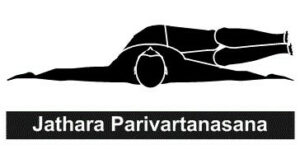
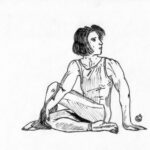
Ardha Matsyendrasana and Marichyasana are seated spinal twists. In these poses, the hips remain stable while the shoulders rotate.
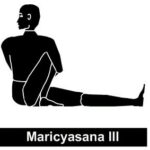
Here is a sample sequence of yoga that you can do in your tent, based on asanas we have discussed and techniques yet to come:
- Kapalabhati breath to cleanse the respiratory system (coming in Part 5)
- Sukha Purvak Pranayama (coming in Part 5)
- Warm ups: Do your favourite seated or kneeling warmups,for example:
- gentle neck stretches,
- Marjariasana (cat pose concave, convex, side to side),
- Supta Padangusthasana (supine leg raises, etc)
- Seated hip/shoulder stretches: (Part 3)
- Parvatanasana (seated mountain pose) or
- Gomukhasana (eagle pose)
- Seated Forward Bends: (Part 3)
- Paschimottanasana (seated forward bend) or
- Janu Sirsasana (head to knee pose) or
- Upavishta Konasana (wide leg forward bend)
- Side Bends: kneeling and supine (Part 2)
- Parighasana (gate pose) or
- Supta Nitambhasana (banana pose)
- Back Bends: (Part 2)
- Bhujangasana (cobra pose) or
- Dhanurasana (bow pose) or
- Ustrasana (camel pose)
- Inversions: (Part 3)
- Meruasana (aka Adho Mukha Svanasana – downward facing dog)
- Twists: (in this Part 4)
- Ardha Matsyendrasana (seated spinal twist aka Lord of the Fishes) or
- Marichyasana (Sage pose) or
- Jathara Parvartanasana (revolved stomach pose /supine spinal twist)
- Relaxation in Savasana of your choice, to integrate the work of the asanas
- Meditation of your choice.
It can be tempting to say, “Well, I won’t do any yoga today because it is wet or snowy or buggy or hot,” but try to stay disciplined. When the temperatures are just too cold or too hot to allow you to do asanas inside your tent, it is time to indulge more in pranayama and meditation. This is yoga too, and we will explore these techniques in Part 5.
To be continued….. Part 5 will conclude this series with Pranayama and Meditation
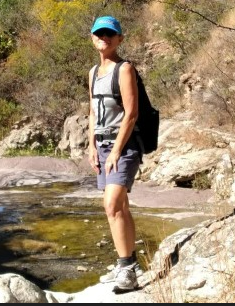
Marion Mugs McConnell is the co-founder of SOYA and the SOYA Yoga Teacher Training program. She is an avid backpacker, hiker, and yoga student. She is the author of Letters from the Yoga Masters: Teachings Revealed through Correspondence from Paramhansa Yogananda, Ramana Maharshi, Swami Sivananda, and Others, published by North Atlantic Books copyright © 2016 ISBN 978-1-62317-035-6.

Recent Comments